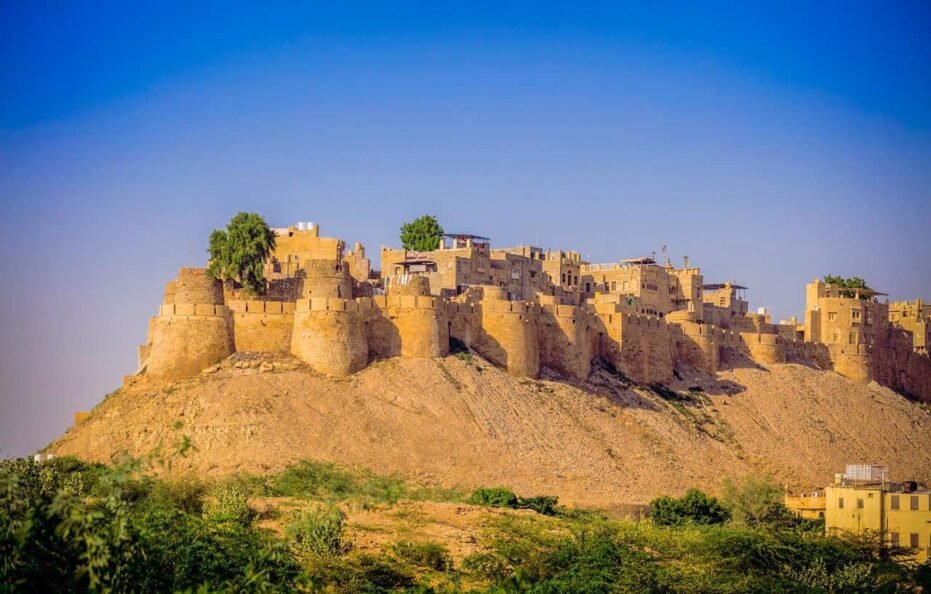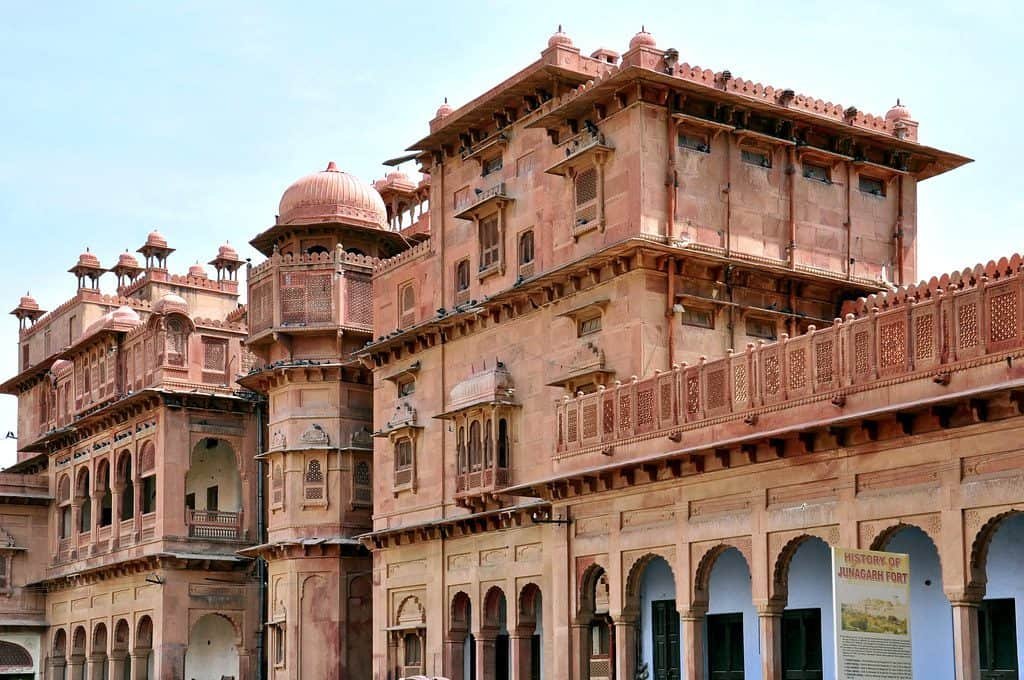



Rajasthan, the largest state in India, is a land of majestic forts, vibrant festivals, and rich cultural heritage. Known as the “Land of Kings,” Rajasthan offers a unique blend of history, art, and natural beauty. From the golden sands of the Thar Desert to the serene lakes of Udaipur, Rajasthan is a treasure trove of experiences that captivate every traveler. Whether you’re a history enthusiast, a nature lover, or a culture buff, Rajasthan has something for everyone. Let’s embark on a journey through this enchanting state.
Rajasthan’s history is a fascinating tapestry of valor, romance, and royalty. The state is home to some of the most magnificent forts and palaces in India, each with its own unique story.
Perched on a hilltop overlooking Maota Lake, Amber Fort is a stunning example of Rajput architecture. The fort’s intricate carvings, mirror work, and expansive courtyards are a testament to the grandeur of the Rajput era.
One of the largest forts in India, Mehrangarh Fort is a formidable structure that offers panoramic views of Jodhpur. The fort’s museum houses an impressive collection of artifacts, including royal palanquins, weapons, and paintings.
A UNESCO World Heritage Site, Chittorgarh Fort is a symbol of Rajput valor and sacrifice. The fort’s massive structure, along with its temples, towers, and reservoirs, offers a glimpse into the glorious past of the Rajput kings.
Rajasthan’s cultural heritage is as vibrant as its landscapes. The state is known for its colorful festivals, traditional music, and dance forms.
Held annually in the town of Pushkar, the Camel Fair is a vibrant celebration of Rajasthan’s rural life. The fair features camel races, folk performances, and a bustling market. It’s a must-visit for anyone looking to experience the essence of Rajasthan.
Known as the “Greatest Literary Show on Earth,” the Jaipur Literature Festival attracts authors, poets, and literary enthusiasts from around the world. The festival is a celebration of literature, ideas, and culture.
Rajasthan is home to a rich tradition of folk music and dance. The soulful melodies of the Manganiyars and the energetic performances of the Kalbeliya dancers are a treat for the senses.
Rajasthan’s cuisine is a delightful blend of flavors, with a focus on vegetarian dishes. Here are some must-try foods:
A traditional Rajasthani dish, Dal Baati Churma consists of baked wheat balls (baati) served with lentil curry (dal) and a sweet crumbled wheat dish (churma). It’s a hearty and flavorful meal.
A spicy meat curry made with red chilies and yogurt, Laal Maas is a favorite among non-vegetarians. The dish is known for its rich and robust flavors.
A popular dessert, Ghewar is a disc-shaped sweet made from flour and soaked in sugar syrup. It’s often garnished with nuts and saffron.
Rajasthan is a shopper’s paradise, offering everything from traditional handicrafts to modern fashion.
Known for its exquisite jewelry, Johari Bazaar is a must-visit for anyone looking to buy traditional Rajasthani jewelry, including Kundan and Meenakari.
Located near the Clock Tower, Sardar Market is a bustling hub for spices, textiles, and handicrafts. The market is a great place to shop for souvenirs and gifts.
Famous for its miniature paintings and traditional Rajasthani attire, Hathi Pol Bazaar is a great place to shop for unique and artistic items.
Rajasthan’s landscapes are as diverse as its culture. From the golden sands of the Thar Desert to the serene lakes of Udaipur, the state offers a variety of natural attractions.
The Thar Desert, also known as the Great Indian Desert, offers a unique and mesmerizing landscape. The desert is home to several wildlife sanctuaries, including the Desert National Park.
A UNESCO World Heritage Site, Keoladeo National Park is a haven for birdwatchers. The park is home to a variety of migratory and resident birds, making it a perfect destination for nature lovers.
A man-made lake, Lake Pichola is one of the most picturesque spots in Udaipur. The lake is surrounded by palaces, temples, and ghats, offering a serene and romantic ambiance.
While Rajasthan’s iconic landmarks like the Amber Fort, Mehrangarh Fort, and Lake Pichola are must-visit attractions, the state also boasts several hidden gems that offer a unique and offbeat experience. If you’re looking to explore Rajasthan beyond the usual tourist spots, here are some lesser-known treasures to add to your itinerary:
A quaint town known for its stunning stepwells, palaces, and lakes, Bundi is often overlooked by tourists. The Bundi Palace and Taragarh Fort offer breathtaking views of the town, while the intricate murals and frescoes are a treat for art lovers.
Located in the Aravalli Range, Kumbhalgarh Fort is a UNESCO World Heritage Site and one of the most impressive forts in Rajasthan. The fort’s massive walls, stretching over 36 kilometers, are second only to the Great Wall of China. The panoramic views from the fort are simply stunning.
Known as the “Open Art Gallery of Rajasthan,” the Shekhawati region is famous for its beautifully painted havelis (mansions). Towns like Mandawa, Nawalgarh, and Fatehpur are dotted with these artistic marvels, showcasing intricate frescoes and murals.
Located in the Pali district, the Ranakpur Jain Temple is a stunning example of Jain architecture. The temple’s intricate marble carvings and 1,444 uniquely carved pillars are a testament to the craftsmanship of the era.
The Bishnoi community is known for its deep respect for nature and wildlife. A visit to the Bishnoi villages near Jodhpur offers a unique opportunity to experience their way of life and witness their conservation efforts.
Often overshadowed by its more famous neighbors, Alwar is a charming town with a rich history. The Alwar Fort, Siliserh Lake, and Sariska Tiger Reserve are some of the key attractions.
While Jaisalmer is famous for its golden fort and sand dunes, the nearby desert villages like Kuldhara and Sam offer a more authentic and tranquil experience. Kuldhara, a deserted village, is shrouded in mystery and folklore.
Rajasthan offers several unique experiences that you won’t find anywhere else in India. Here are some to add to your itinerary:
Rajasthan is home to several heritage hotels that were once palaces and havelis. Staying in one of these hotels, such as the Umaid Bhawan Palace in Jodhpur or the Lake Palace in Udaipur, offers a royal experience.
Rajasthan’s folk festivals, such as the Marwar Festival in Jodhpur and the Camel Festival in Bikaner, offer a vibrant celebration of the state’s culture and traditions. The festivals feature folk music, dance, and traditional sports.
Experience the breathtaking landscapes of Rajasthan from a hot air balloon. Companies in Jaipur and Pushkar offer balloon rides that provide a bird’s-eye view of the forts, palaces, and deserts.
Rajasthan is home to several stunning stepwells, such as the Chand Baori in Abhaneri and the Panna Meena Ka Kund in Jaipur. These architectural marvels are not only functional but also aesthetically pleasing.
If you have extra time, consider exploring these nearby destinations:
Agra: About 4 hours from Jaipur, Agra is home to the iconic Taj Mahal and Agra Fort.
Delhi: About 5 hours from Jaipur, Delhi offers a wealth of historical and cultural attractions.
Mount Abu: Rajasthan’s only hill station, Mount Abu is about 4 hours from Udaipur and offers a cool retreat with its lush greenery and serene lakes.
As a responsible traveler, you can contribute to preserving Rajasthan’s heritage and environment:
Support local artisans and businesses by purchasing handmade crafts and souvenirs.
Avoid littering and use eco-friendly products.
Respect wildlife and follow guidelines at national parks and sanctuaries.
Rajasthan’s rich cultural heritage is reflected in its traditional art and craft. Here are some unique items to look out for:
Jaipur is famous for its blue pottery, which is made from quartz and not clay. The intricate designs and vibrant colors make it a popular souvenir.
Rajasthan is known for its miniature paintings, which depict scenes from Hindu mythology, royal courts, and nature. Udaipur and Jaipur are the best places to buy these exquisite artworks.
The art of block printing is a traditional craft in Rajasthan, especially in towns like Jaipur and Bagru. The intricate patterns and vibrant colors make block-printed textiles a must-buy.
Jodhpur is famous for its leather goods, including shoes, bags, and belts. The city’s leather products are known for their quality and craftsmanship.
Best Time to Visit: October to March, when the weather is pleasant.
Transportation: Rajasthan has a well-connected network of buses, trains, and flights. Local transport includes auto-rickshaws, taxis, and cycle rickshaws.
Dress Code: Dress modestly, especially when visiting religious sites.
Language: Hindi and Rajasthani are the primary languages, but most people in the tourism industry speak English.
Rajasthan is a state that offers a perfect blend of history, culture, and natural beauty. Whether you’re exploring its majestic forts, participating in its vibrant festivals, or savoring its culinary delights, Rajasthan promises an unforgettable experience.
So pack your bags, put on your explorer’s hat, and get ready to discover the wonders of Rajasthan. The Land of Kings awaits you!
Have you explored Rajasthan’s hidden gems? Share your experiences and tips in the comments below! If you haven’t, what are you most excited to explore? Let us know!
Subscribe to see secret deals prices drop the moment you sign up!
